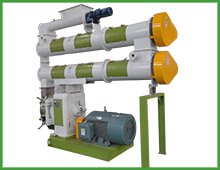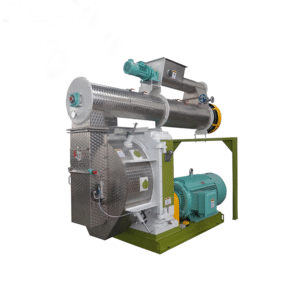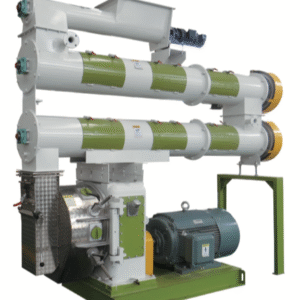Description
Technical Specifications & Engineering Design
Drive & Power Transmission
-
Main Motor: 75-400 kW (dependent on capacity and formulation complexity)
-
Gearbox: Hardened spiral bevel gears, torque ratings 30,000-180,000 Nm
-
Feeder Motor: 1.5-7.5 kW variable speed drive
-
Conditioner Motor: 11-45 kW with speed modulation
Pelletization System
-
Die Diameter: 400-1,200 mm (marine-grade stainless steel)
-
Die Thickness: 40-120 mm (species-specific L/D ratios)
-
Roller Configuration: 2-3 rollers, centrifugal cast iron with tungsten carbide overlay
-
Die Working Area: 0.12-0.45 m² (determines production capacity)
Conditioning Technology
-
Pre-conditioner Type: Single or dual shaft with adjustable paddles
-
Retention Time: 90-240 seconds (programmable based on formula)
-
Steam Addition: 3-8% dry steam at 2-6 bar pressure
-
Liquid Binding Systems: 2-6% addition capacity with precision metering
Species-Specific Production Parameters
| Target Species | Pellet Size Range | Buoyancy Profile | Optimal Moisture | Production Capacity |
|---|---|---|---|---|
| Salmonids | 3-12 mm | Slow-sinking | 14-16% | 5-15 t/h |
| Marine Finfish | 2-8 mm | Sinking | 12-14% | 3-10 t/h |
| Shrimp | 1.0-2.5 mm | Sinking, high stability | 10-12% | 2-6 t/h |
| Tilapia/Carp | 2-6 mm | Floating/Slow-sinking | 16-18% | 4-12 t/h |
| Ornamental Fish | 0.5-1.5 mm | Floating/Sinking options | 8-10% | 1-3 t/h |
Quality Performance Metrics:
-
Pellet Durability Index (PDI): >95%
-
Fines Generation: <3%
-
Water Stability: 1-6 hours (species-dependent)
-
Starch Gelatinization: 85-95%
Innovative Features & Technological Integration
Intelligent Process Control
-
PLC/HMI systems with recipe management (100+ formulations)
-
Real-time monitoring of amperage, temperature, and pressure
-
Automated gap adjustment between die and rollers
-
Production data logging for traceability and optimization
Advanced Conditioning Systems
-
Twin-shaft preconditioners with variable pitch paddles
-
Direct steam injection with proportional control
-
Liquid addition systems with high-pressure atomization
-
Retention time optimization for ingredient functionality
Specialized Die Technology
-
Spiral die hole distribution for uniform wear
-
Step-cone hole geometry for optimized compaction
-
Bimetal construction (stainless steel body with carbide inserts)
-
Quick-change systems for reduced downtime
Operational Performance & Economic Analysis
Energy Efficiency Metrics
-
Specific Energy Consumption: 35-65 kWh/ton
-
Steam Consumption: 40-80 kg/ton
-
Pellet Mill Efficiency: 85-92% (theoretical maximum)
-
Overall Equipment Effectiveness (OEE): >85%
Economic Advantages
-
Improved FCR: 1.2-1.8 (species-dependent)
-
Reduced Production Costs: $15-35/ton compared to conventional systems
-
Enhanced Product Value: 20-40% premium for high-quality pellets
-
Return on Investment: 18-36 months
Case Study – Norwegian Salmon Feed Producer:
After implementing a modern aqua feed pellet mill, the company documented:
-
Production capacity increase: 28% (8 to 10.2 t/h)
-
Pellet durability improvement: 92% to 97%
-
Energy consumption reduction: 22%
-
Feed conversion ratio improvement: 1.4 to 1.2
Maintenance & Reliability Engineering
Preventive Maintenance Program
-
Daily: Visual inspection, lubrication check, vibration monitoring
-
Weekly: Die and roller wear measurement, belt tension verification
-
Monthly: Gearbox oil analysis, bearing condition assessment
-
Quarterly: Complete system audit and calibration
Critical Wear Components
-
Die Life: 4,000-12,000 hours (depending on abrasiveness)
-
Roller Life: 3,000-8,000 hours
-
Feeder Liners: 6,000-10,000 hours
-
Conditioner Paddles: 8,000-15,000 hours
Sustainability & Environmental Considerations
Resource Efficiency
-
Water Consumption: 0.3-0.6 m³/ton of pellets
-
Energy Recovery: Heat exchange systems capture 25-40% of waste heat
-
Emission Control: Dust collection efficiency >99.5%
Circular Economy Integration
-
By-product utilization from food and agricultural industries
-
Alternative protein source incorporation
-
Reduced environmental impact through improved FCR
Future Development Trajectory
Emerging Technologies
-
Artificial Intelligence for process optimization
-
Digital twin technology for predictive maintenance
-
Advanced sensor systems for real-time quality control
-
Integration with aquaculture management software
Market Evolution
-
Increased demand for functional and specialized feeds
-
Sustainability certification requirements
-
Traceability and transparency expectations
-
Customization for emerging aquaculture species
The aqua feed pellet mill continues to evolve as a sophisticated manufacturing platform, balancing production efficiency with nutritional excellence. Its role in sustainable aquaculture expansion remains crucial, providing the technological foundation for producing feeds that support healthy fish growth while minimizing environmental impact. As aquaculture continues to be the fastest-growing animal protein sector, these advanced pellet mills will play an increasingly vital role in meeting global seafood demand.





Reviews
There are no reviews yet.